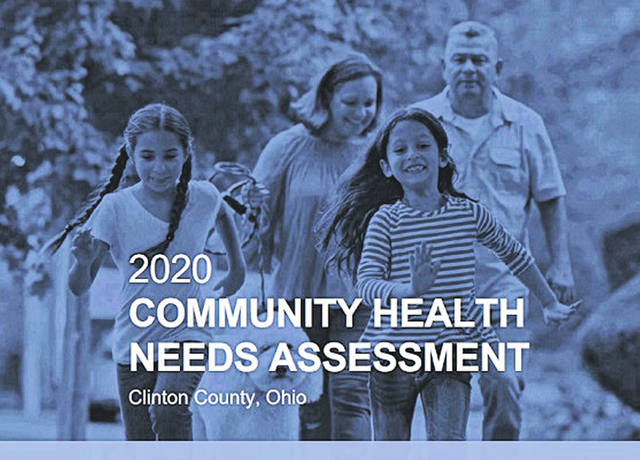
Note: This article is part 2 highlighting and summarizing the 2020 Community Health Needs Assessment report for Clinton County, a comprehensive study done by a health care consulting firm. The 2020 assessment is a follow-up to similar studies conducted here in 1996, 2001 and 2015.
WILMINGTON — Nearly 8 in 10 Clinton County adults (79.3 percent) are overweight, according to the 2020 Community Health Needs Assessment report.
That’s well above state (68.4 percent) and national (61 percent) figures, and has been increasing significantly over time, the assessment report states.
The overweight group includes about 38 percent of Clinton County adults who are classified obese, worse than the U.S. percentage.
The obesity number marks a steady, significant increase in obesity incidence here since 1996. Obesity incidence is higher among adults 45 and older, and those in low-income households.
Between 2016 and 2018, Clinton County’s annual average age-adjusted diabetes mortality rate was well above the state and national mortality rates. And the trend here shows diabetes mortality has increased over time, running counter to stable or slowly decreasing trends statewide and nationally.
In addition, 17 percent of Clinton County adults report having been diagnosed with diabetes, worse than the statewide percentage. Moreover, this 17 percent figure is a significant increase from the earliest survey findings, according to the assessment report.
Among local adults age 18 to 64, a little over 8 percent report having no insurance coverage for health care expenses.
Roughly 35 percent of local adults report some type of difficulty or delay in obtaining health care services in the past year. Nevertheless, that is a significant improvement since 2015, according to the assessment report.
Regarding cancer, between 2016 and 2018 Clinton County had an annual average age-adjusted cancer mortality rate worse than the national mortality rate. On a more positive note, despite a recent uptick, the county rate has decreased over the past decade.
Together, heart disease and cancers accounted for nearly half of all deaths in Clinton County in 2018, noted the report.
Number eight on the prioritized list of local health concerns is tobacco use. Approximately 26 percent of Clinton County adults currently smoke cigarettes, either regularly (every day) or occasionally (on some days).
The tobacco use percentage is described as well above state and national figures. The incidence of use decreases with age.
The 2020 Community Health Needs Assessment report for Clinton County also looked at things such as motor vehicle safety and firearm safety.
Nearly 29 percent of survey respondents admit to distracted driving — have sent or read texts or emails while driving — in the past month. The activity is especially high among upper-income residents, the report said.
Most Clinton County adults (82.6 percent) report “always” wearing a seat belt in the car, increasing significantly from the 1996 and 2001 survey findings.
About 22 percent report they have guns or other firearms in or around their house or vehicles that are currently unlocked (no key or combination is needed to fire the gun).
Under the category of financial resilience, 17 percent of Clinton County residents would not be able to afford an unexpected $400 expense without going into debt, according to the assessment.
Overall, 10.6 percent of survey respondents have ever been homeless. In the past two years, 3.6 percent of adults reported living on the street, in a car, or in a temporary shelter at some point.
Also in the past two years, 7 percent of survey respondents lived with a friend or relative due to a housing emergency.
Overall, 16.3 percent of residents are determined to be “food insecure,” having run out of food in the past year and/or been worried about running out of food. That’s less than half the national proportion.
Roughly 15 percent of local adults acknowledge that they have ever been hit, slapped, pushed, kicked, or otherwise hurt by an intimate partner.
Numbers for care giving show almost one out of three (31.8 percent) of Clinton County adults currently provide care or assistance to a friend or family member who has a health problem, long-term illness, or disability. That is higher than the U.S. rate, which is 22.6 percent.
Close to 27 percent of Clinton County adults are limited in some way in some activities due to a physical, mental, or emotional problem, increasing significantly from 1996 and 2001 survey results, the report states.
This limitation in some activities is reported more often among adults 45 and older and especially those in low-income households.
In the category of teenage birth rate between 2012 and 2018, the county reported 31.3 births to females age 15 to 19 per 1,000 women in that age range in Clinton County. That is above the Ohio (23.9 percent) and U.S. (22.7 percent) rates.
Among Clinton County adults, 18.5 percent believe their overall health is “fair” or “poor.”
The 2020 Community Health Needs Assessment was sponsored by the Board of Clinton County Commissioners, the Clinton County Health District, Clinton Memorial Hospital, HealthFirst for Clinton County, and the Mental Health Recovery Board (serving Warren and Clinton Counties).
Reach Gary Huffenberger at 937-556-5768.


